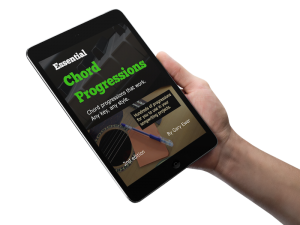Here’s an interesting and easy way to create chord progressions that move back and forth from minor key to major. Progressions that shift major/minor focus in this way help to create fluctuating moods that work especially well in song verses and bridge sections.
To do this, you need to know that every minor key has a relative major key associated with it. For example, the key of A minor is the relative minor of C major. That’s because they both use the same key signature.
 If you find chord progressions hard to create, and you just need some to get your songwriting process started, you need “Essential Chord Progressions, and “More Essential Chord Progressions.” They’re collections of chords that you can use as is, or modify to suit your needs. They’re both part of “The Essential Secrets of Songwriting 10-eBook Bundle.
If you find chord progressions hard to create, and you just need some to get your songwriting process started, you need “Essential Chord Progressions, and “More Essential Chord Progressions.” They’re collections of chords that you can use as is, or modify to suit your needs. They’re both part of “The Essential Secrets of Songwriting 10-eBook Bundle.
You don’t really need to know the theory behind this, so if you’re not up on your relative major-minor keys, here’s a page that lists them all. (Thanks to the folks at musictheorysite.com)
So try this:
- Create a simple minor key progression. All you need is something very basic: i iv iiº v i. In the key of A minor, these chords would be: Am Dm Bdim Em Am
- Now think of these chords as being a set of pairs. In other words, Am-Dm is a pair, Bdim and Em is another pair, etc.
- Create a new progression in this way: Start by writing down the first pair: i iv (Am-Dm). Follow it with the relative major key version of the same pair. The relative major key of A minor is C major, so I IV in C major gives us these chords: C F.
- Now write down the 3rd and 4th chords in your A minor progression: iiº v (Bdim-Em). Follow those with the relative major key equivalent: ii V (Dm G)
- Finish with your original ending chord: i (Am). If you’re moving on to your song’s chorus, you may want to switch entirely to major, so in that case end with I (C), and continue with a C major progression of your choice.
Following that method means that you start with this: Am Dm Bdim Em Am, and you end with this:
Am Dm C F| Bdim Em Dm G |Am
Once you’ve done it, you can then go back into your new progression and make changes to anything you don’t particularly like. For example, you may find that the jump from F to Bdim is a little jarring, and if it’s not suiting your song, you could change Bdim to something else, or even keep it, but use a different bass note: Bdim/D, for example.
The great thing about this method is that it doesn’t require you to stick to this process the entire way through. You may find that once you’ve done the third step, you’d like to jump out of the process and continue with your own choices.
Once you’ve created your new progression, you’ve also got many options for how you use it. You might, for instance, vamp back and forth between the first two chords (Am-Dm) several times before moving on.
You can also start the whole process by grouping together three of the original chords instead of just two. The possibilities, as they say, are endless.
You can hear what switching from minor to major can do for your song by listening to Sia Furler’s “Soon We’ll Be Found.” You hear a minor key Cm-Fm start, followed by a relative major version in Eb major (which opts to use a minor iv borrowed chord instead of the expected major IV).
 Written by Gary Ewer. Follow Gary on Twitter.
Written by Gary Ewer. Follow Gary on Twitter.
 If you like starting songs by working out a good chord progression, you need to get “Writing a Song From a Chord Progression.” It shows you the strengths and pitfalls of this very common songwriting process.
If you like starting songs by working out a good chord progression, you need to get “Writing a Song From a Chord Progression.” It shows you the strengths and pitfalls of this very common songwriting process.










